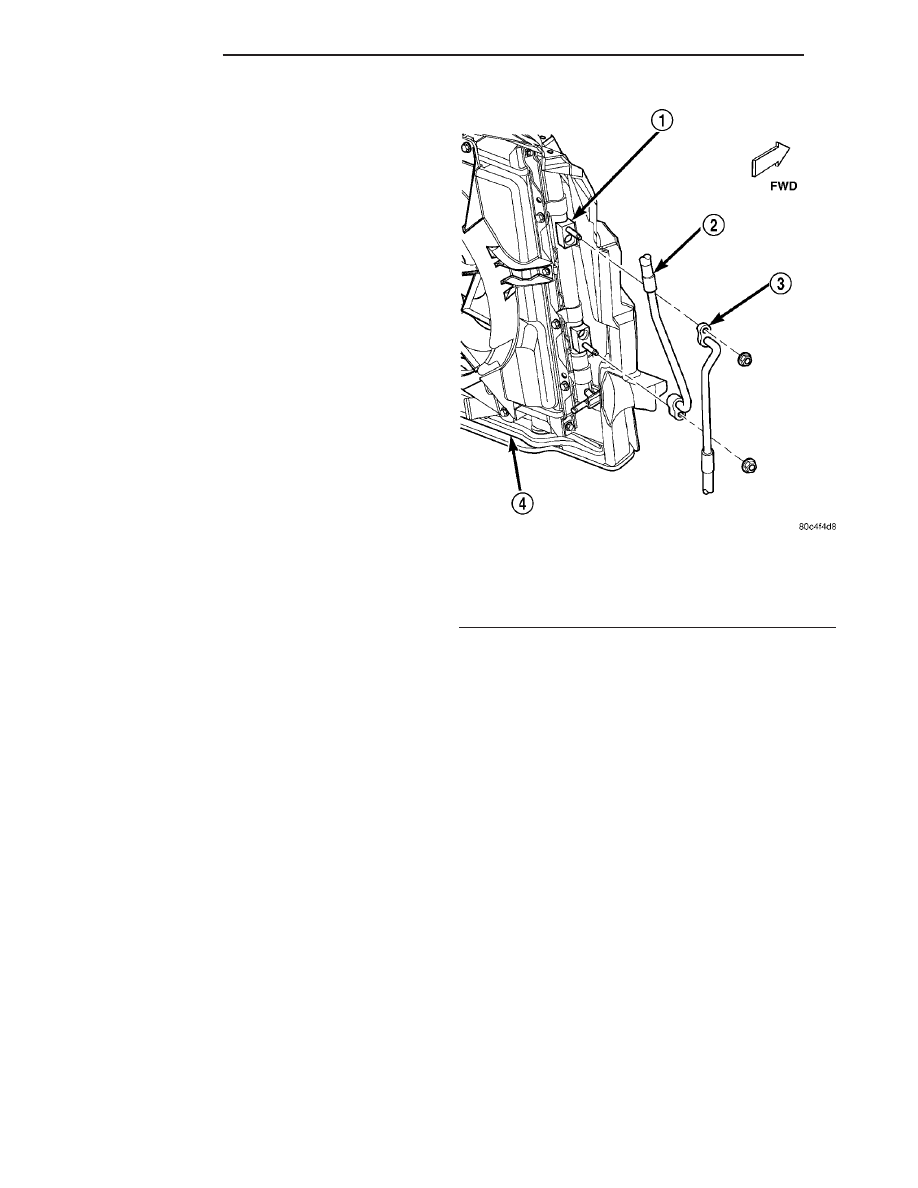Chrysler PT Cruiser. Manual - part 981

REMOVAL
WARNING: Review safety precautions and warnings
in this group before performing this procedure
(Refer to 24 - HEATING & AIR CONDITIONING/
PLUMBING - WARNINGS) and (Refer to 24 - HEAT-
ING & AIR CONDITIONING/PLUMBING - CAUTIONS).
Failure to follow the warnings and cautions could
result in possible personal injury or death.
(1) Disconnect and isolate the negative battery
cable.
(2) Recover the refrigerant from the refrigerant
system (Refer to 24 - HEATING & AIR CONDITION-
ING/PLUMBING
-
STANDARD
PROCEDURE
-
REFRIGERANT SYSTEM RECOVERY).
(3) Remove the battery support strut.
(4) Remove the nut that secures the A/C liquid line
from the A/C condenser.
(5) Disconnect the A/C liquid line from the A/C
condenser and remove and discard the O-ring seal.
(Fig. 7).
(6) Install plug in, or tape over the opened liquid
line fitting and the condenser outlet port.
(7) Remove the nut that secures the A/C discharge
line from the A/C condenser.
(8) Disconnect the A/C discharge line from the A/C
condenser and remove and discard the O-ring seal.
(9) Install plug in, or tape over the opened dis-
charge line fitting and the condenser inlet port.
(10) Remove upper radiator mounts (Refer to 7 -
COOLING/ENGINE/RADIATOR - REMOVAL)
(11) Remove the condenser retaining screws.
(12) Tilt the radiator back and carefully remove
the A/C condenser from the engine compartment.
INSTALLATION
NOTE: If the A/C condenser is being replaced, add
30 milliliters (1 fluid ounce) of refrigerant oil to the
refrigerant system. Use only refrigerant oil of the
type recommended for the A/C compressor in the
vehicle.
(1) Tilt the radiator back and position the A/C con-
denser into the engine compartment.
(2) Install the screws that secure the A/C con-
denser to the radiator. Tighten the screws to 2 N·m
(17 in. lbs.).
(3) Install the upper radiator mounts (Refer to 7 -
COOLING/ENGINE/RADIATOR - INSTALLATION).
(4) Remove the tape or plug from the condenser
inlet port and the discharge line fitting.
(5) Lubricate a new rubber O-ring seal with clean
refrigerant oil and install it on the discharge line fit-
ting. Use only the specified O-ring as it is made of a
special material for the R-134a system. Use only
refrigerant oil of the type recommended for the com-
pressor in the vehicle.
(6) Connect the A/C discharge line to the A/C con-
denser.
(7) Install the nut that secures the A/C discharge
line to the A/C condenser. Tighten the nut to 5 N·m
(44 in. lbs.).
(8) Remove the tape or plug from the condenser
outlet port and the liquid line fitting.
(9) Lubricate a new rubber O-ring seal with clean
refrigerant oil and install it on the liquid line fitting.
Use only the specified O-ring as it is made of a spe-
cial material for the R-134a system. Use only refrig-
erant oil of the type recommended for the compressor
in the vehicle.
(10) Connect the A/C liquid line to the A/C con-
denser.
(11) Install the nut that secures the A/C liquid line
to the A/C condenser. Tighten the nut to 5 N·m (44
in. lbs.).
(12) Install the battery support strut.
(13) Reconnect the negative battery cable.
(14) Evacuate the refrigerant system (Refer to 24 -
HEATING & AIR CONDITIONING/PLUMBING -
STANDARD PROCEDURE - REFRIGERANT SYS-
TEM EVACUATE)
Fig. 7 A/C Condenser Refrigerant Lines - Typical
1 - A/C CONDENSER
2 - A/C LIQUID LINE
3 - A/C DISCHARGE LINE
4 - RADIATOR ASSEMBLY
24 - 46
PLUMBING
PT
A/C CONDENSER (Continued)